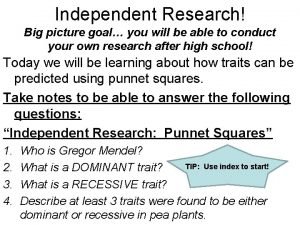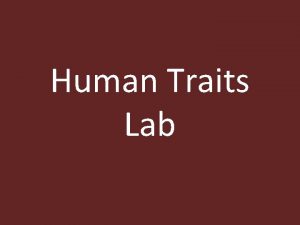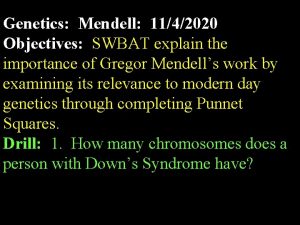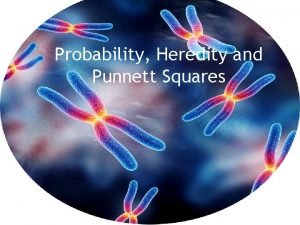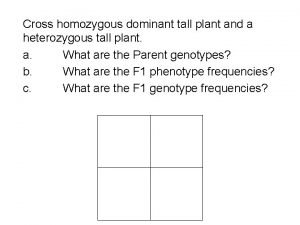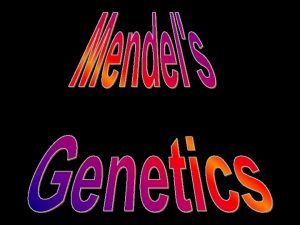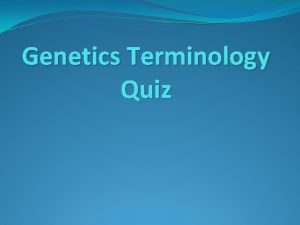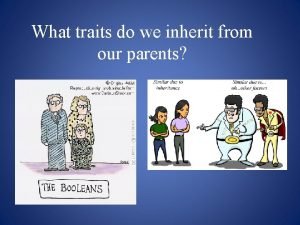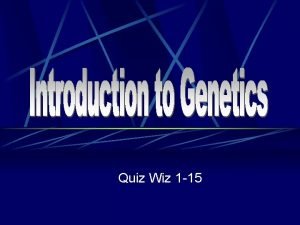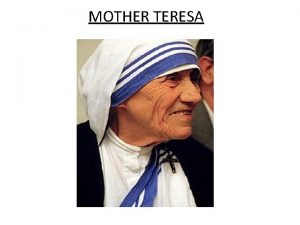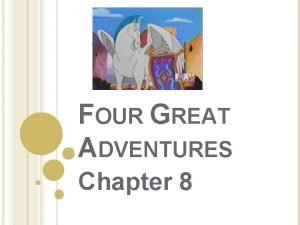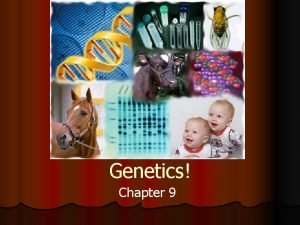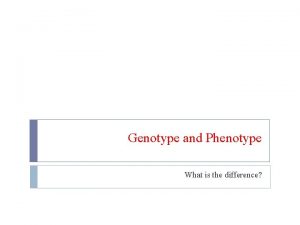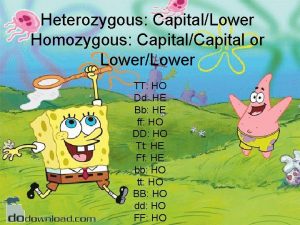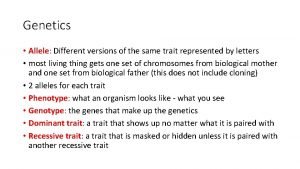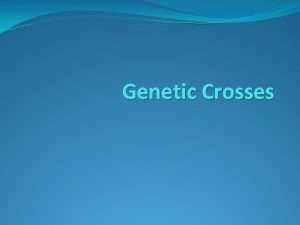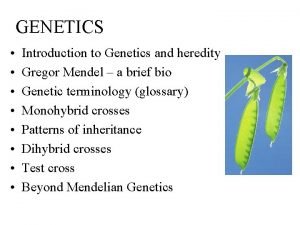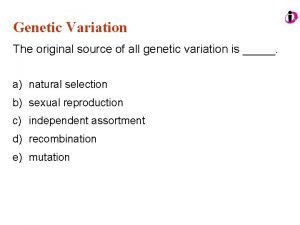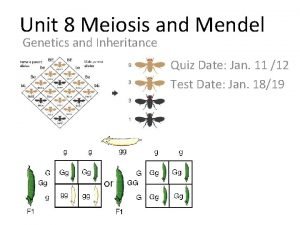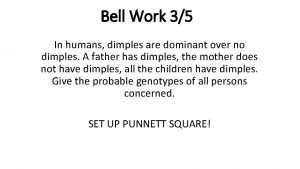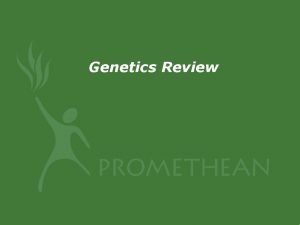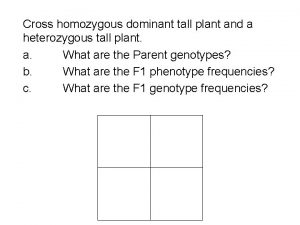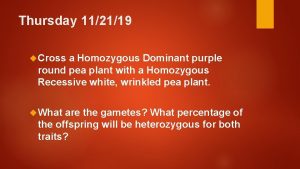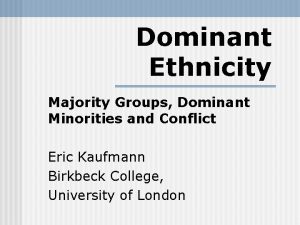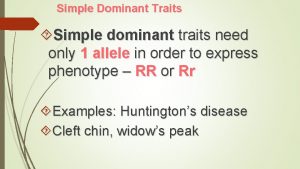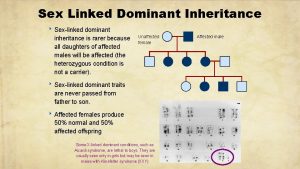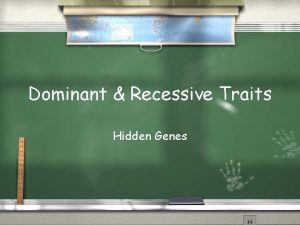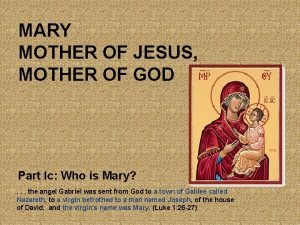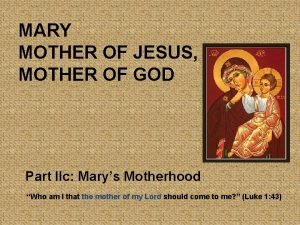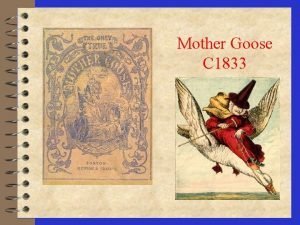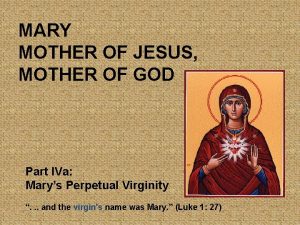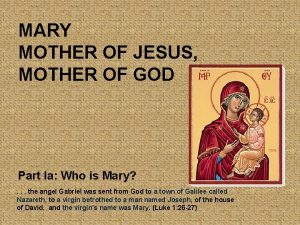A mother is homozygous dominant for dimples The























- Slides: 23

A mother is homozygous dominant for dimples. The father does not have dimples. Based on your understanding of meiosis and fertilization, what is the probability that they will have a child with dimples? A. B. C. D. 100% 75% 50% 0%

�The separation of allele pairs occurs during _________ and the recombining of allele pairs occurs during ________.

Genetics Vocabulary • • • Heredity- Gene – Alleles. Genotype – Phenotype – Dominant – Recessive – Homozygous – Heterozygous. Cross- • • • Genotype with two different alleles (ex. Aa) The physical expression of a genotype (ex. pigmentation or no pigmentation) An allele that is masked over the dominant allele (ex. a) Versions of genes- same type of gene but different codes Genotype with the same alleles (ex. AA, aa) Segment of DNA that codes for a protein Mating or breeding of two individuals The transmission of characteristics from parents to offspring Allele that is always expressed phenotypically (ex. A) Allele combination(ex. AA, Aa, 0 r aa)

Mendelian Genetics • Genetics- the field of biology devoted to understanding how characteristics are transmitted from parents to offspring • Gregor Mendel- the founder of genetics – Figured out the principles of inheritance through experiments

Pea plant experiments • Mendel was a botanist • Wanted to figure out how characteristics were passed on over generations in plants in order to breed the plants he wanted • Did experiments with pea plants

Mendel’s Principles of Inheritance • ____________- a pair of alleles are segregated (separated) during the formation of gametes • ____________- allele pairs are segregated independently of other allele pairs

PRACTICE MAKING GAMETES for a MONOHYBRID CROSS Tall = ____ T t Short = ____ R Round seeds = ___ r Wrinkled seeds = ___

What are the possible gametes? Homozygous Tall parent = What gametes can it produce? T TT T

What are the possible gametes? PURE wrinkled parent = What gametes can it produce? r rr r

What are the possible gametes? Heterozygous Round parent = What gametes can it produce? R Rr r

What are the possible gametes? Hybrid Tall parent = What gametes can it produce? T Tt t

What are the possible gametes OR • Heterozygous tall and heterozygous round parent

Eye color gene: red (A) white (a) Size gene: big (B) small (b) Individual genotype Aa. Bb Orientation of homologous chromosomes is random <-- or --> Bb Aa BA ba Bb a. A Ba Possible allele combinations for two types of genes b. A

A gecko species can have two distinct colorations, green or yellow. Green (G) is dominant to yellow (g). If a gecko is green but is heterozygous for the trait, what are his possible gamete genotypes? A. B. C. D. E. [Default] [MC Any] [MC All] Half of gametes will be GG, half will be gg All of gametes will be G All of gametes will be g Half of gametes will be G, half will be g

How he figured it out…. Pea traits Mendel studied the characteristics of pea plants that had two distinct versions: Ex) purple flowers or white flowers

P generation cross When he crossed pure bred white flowers with pure bred purple flowers, he thought he would get both white and purple flowers, or light purple flowers, but…. He only got purple flowers. Why? Punnett Square: Possible genotypes: Possible Phenotypes:

F 1 generation cross When he crossed the F 1 generation of purple flowers with each other, he got about 75% purple flowers and 25% white flowers. Why? monohybrid cross Punnett Square: Genotypic ratio: Phenotypic ratio:

Practice 1. Being able to roll your tongue (R) is dominant over not being able to roll your tongue (r). Todd and Susan can both roll their tongue. Todd is homozygous for the trait and Susan is heterozygous. Predict the genotypic and phenotypic ratios of the possible offspring.

• A monohybrid cross just looks at the inheritance of one gene (ex. Seed shape) – Ex) what is the probability of inheriting a widow’s peak? • A dihybrid cross shows the inheritance pattern of two genes together (ex. Seed shape and stem length) – Ex) what is the probability of inheriting a widow’s peak and attached earlobes?

Dihybrid Crosses • Prediction of inheritance involving two genes • Cross two pea plants that are both heterozygous for pea color (Gg) and pea texture (Rr) – phenotypic ratio _______________

Practice 1. Having dimples (D) is a dominant trait. Mr. Wilson has dimples, but his wife does not. However, all 4 of their children have dimples! Show the most likely Punnett square that represents the Wilson family: 2. Is it possible for them to have a child without dimples? Explain.

Dihybrid Cross Practice • In guinea pigs, black coat color (B) is dominant to white coat color (b) and short hair (H) is dominant to long hair (h) • A male heterozygous for black coat and with long hair is crossed with a female with a white coat and heterozygous for short hair. 1. What are the parent’s genotypes? 2. Determine the phenotypic probabilities of the offspring. 3. Determine if your expected values are significantly different than the observed numbers in the offspring: 45 black, short ;

• In humans there is a disease called Phenylketonuria (PKU), caused by a recessive allele that doesn’t code for the enzyme that breaks down the amino acid phenylalanine. This disease can result in mental retardation or death. Let “E” represent the normal enzyme. • Also in humans there is a condition called galactose intolerance or galactosemia, caused by a recessive allele. Let “G” represent the normal allele for galactose digestion. • In both diseases, normal dominates over recessive. • Two parents come to a geneticist, concerned about having a baby with the above genetic disorders. The father is a carrier for PKU and has galactosemia. The mother is also a carrier for PKU and a carrier for galactosemia. • Write out the genotypes and phenotypes of the parents • Perform a cross to determine the chance of having a child with just PKU, just galactosemia, and the chance of having both diseases.
 Are dimples dominant or recessive
Are dimples dominant or recessive Dimples are dominant or recessive
Dimples are dominant or recessive Punnett square example
Punnett square example Punnett square blood type
Punnett square blood type Phenotype punnett square
Phenotype punnett square Homozygous dominant
Homozygous dominant Punnett square example
Punnett square example Gene terminology
Gene terminology Are dimples inherited or acquired
Are dimples inherited or acquired Hand clasping dominant or recessive
Hand clasping dominant or recessive Wiz1 alternative
Wiz1 alternative Which individual in the first generation is a carrier?
Which individual in the first generation is a carrier? Life is a dream mother teresa
Life is a dream mother teresa Chapter 8 mother to mother
Chapter 8 mother to mother One trait
One trait Which is heterozygous?
Which is heterozygous? Heterozygous example
Heterozygous example Tt ho
Tt ho 5 rows and 2 columns
5 rows and 2 columns Tt x tt punnett square
Tt x tt punnett square Genotype example
Genotype example Mendel
Mendel The original source of all genetic variation is
The original source of all genetic variation is Chromosome number of human
Chromosome number of human
